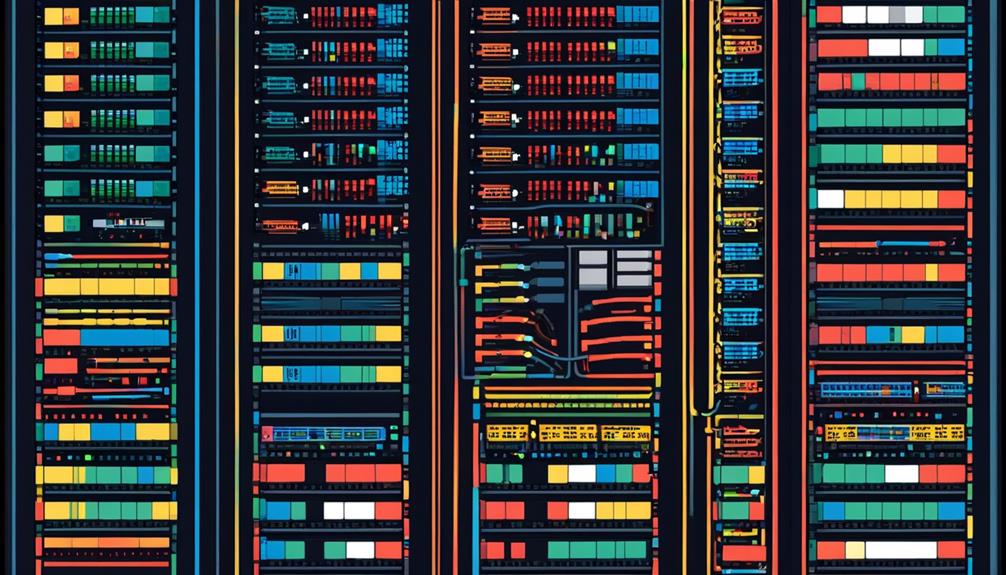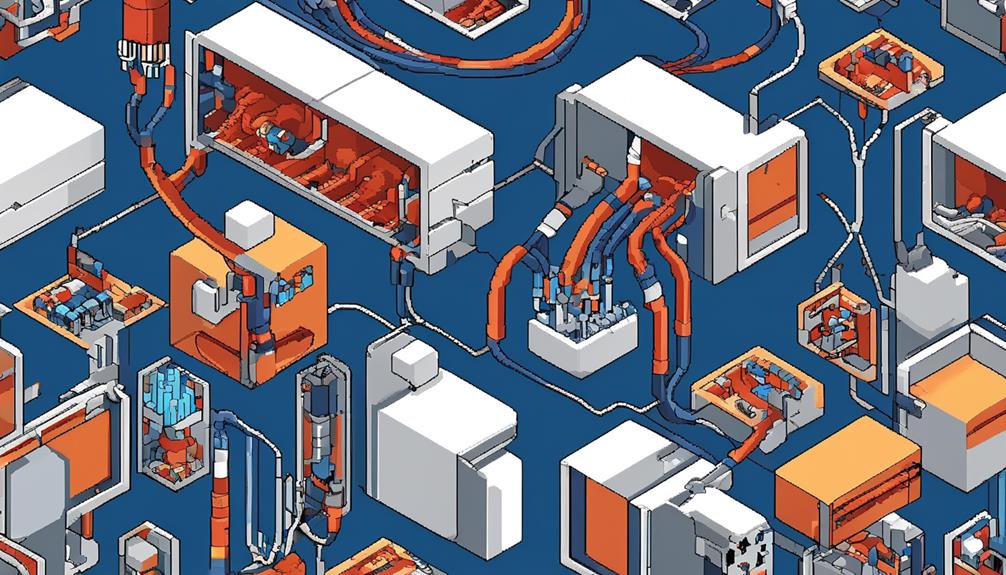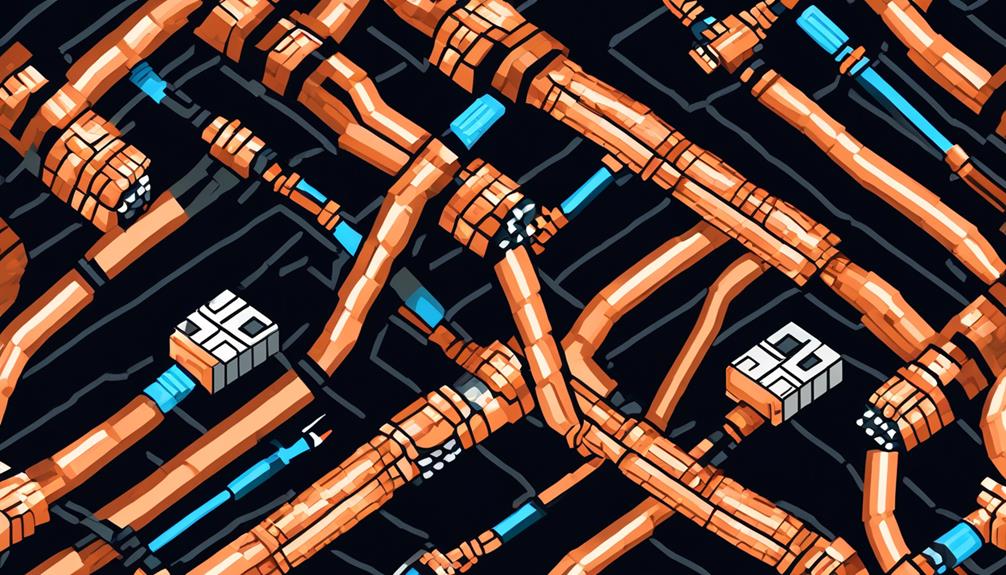In today's interconnected world, the importance of network cabling cannot be overstated. It forms the backbone of any computer network, allowing devices to communicate seamlessly and efficiently. But what exactly is network cabling and why is it so crucial?
In this discussion, we will delve into the intricacies of network cabling, exploring the different types of cables and their applications in various network environments. From the reliable coaxial cables to the lightning-fast fiber optic cables, we will unravel the mysteries behind these essential components.
So, if you're curious to uncover the secrets of network cabling and understand how it can revolutionize your network infrastructure, then let's begin our journey into the world of wires and connections.
Key Takeaways
- Network cabling is important for reliable and efficient communication between devices.
- Different types of network cabling, such as twisted pair, coaxial, and fiber optic cables, serve different purposes and have specific advantages.
- Common network cabling issues include cable congestion, damage, signal interference, poor labeling, and inadequate documentation.
- Proper installation and organization of network cables facilitate troubleshooting, maintenance, and support for network applications and services.
Importance of Network Cabling

The importance of network cabling lies in its ability to ensure reliable and efficient communication between devices, ultimately enhancing business operations and minimizing downtime. Network cables are the physical medium that allows devices to connect and transfer data. Ethernet cables, specifically, are commonly used for this purpose. They provide a stable and secure connection, allowing for the seamless transmission of data.
Proper installation of network cabling is crucial for supporting various network applications and services. It ensures that devices can communicate effectively, enabling employees to collaborate and access shared resources without interruption. This is especially important in today's digital age, where businesses rely heavily on technology for their operations.
Organized and labeled cables are essential for troubleshooting and maintenance purposes. With clear labeling and cable management, IT professionals can quickly identify and resolve any issues that may arise. In addition, well-organized cabling allows for easy scalability and future expansion, as new devices can be easily integrated into the existing network infrastructure.
Factors to consider in network cabling include bandwidth requirements, cable length, environmental factors, installation cost, and compliance with industry standards. By carefully considering these factors, businesses can ensure that their network cabling meets their specific needs and is capable of delivering optimal performance.
Common network cabling issues include cable congestion, cable damage, signal interference, poor cable labeling, and inadequate documentation. These issues can lead to connectivity problems, slow data transfer speeds, and increased downtime. Therefore, proper installation, regular maintenance, and adherence to industry best practices are essential to minimize these issues and maximize the efficiency of the network.
Types of Network Cabling
With the importance of network cabling established, it is essential to explore the various types of cables used in networking to ensure reliable and efficient communication between devices. Here are the four main types of network cabling:
- Twisted Pair Cable:
- Twisted pair cables are commonly used for Ethernet cabling.
- They consist of pairs of insulated copper wires twisted together, which helps reduce electromagnetic interference.
- The two main types of twisted pair cables are Unshielded Twisted Pair (UTP) and Shielded Twisted Pair (STP).
- UTP cables are the most common and cost-effective option for Ethernet networks.
- Coaxial Cable:
- Coaxial cables are mainly used for cable TV and broadband internet connections.
- They consist of a central conductor surrounded by insulation, a metallic shield, and an outer protective layer.
- Coaxial cables provide better shielding against interference and offer higher bandwidth compared to twisted pair cables.
- Fiber Optic Cable:
- Fiber optic cables use thin strands of glass or plastic to transmit data as pulses of light.
- They offer high-speed data transmission over long distances with minimal signal loss.
- Fiber optic cables are immune to electromagnetic interference and provide secure and reliable communication.
- They are commonly used in high-bandwidth applications such as data centers, telecommunications, and long-distance networking.
- Crossover Cable:
- A crossover cable is a specialized Ethernet cable used to connect similar devices directly, such as two computers or two switches, without the need for a hub or a switch.
- It allows for the exchange of data between the devices by crossing over the transmit and receive pairs.
Understanding the different types of network cabling is crucial for designing and implementing a structured cabling system that meets the specific needs of an organization. By selecting the right type of cable for each application, businesses can ensure efficient and reliable communication between devices, enabling seamless connectivity and data transfer.
Coaxial Cable

Coaxial cables, commonly used for cable TV and broadband internet, are designed to transmit high-frequency signals over long distances with minimal interference and signal loss. These cables consist of a copper conductor surrounded by insulation, a woven metallic shield, and an outer insulating layer. This construction provides protection against interference and signal loss, making coaxial cables suitable for high-speed data transmission. They are used in various communication applications, including CCTV systems and satellite connections.
Coaxial cables are known for their ability to carry higher bandwidths compared to twisted pair cables, making them ideal for high-demand networking environments. They are widely used in residential and commercial networking setups, providing a reliable choice for transmitting audio, video, and data signals.
In the realm of network cabling services, coaxial cables are often used in local area networks (LANs) and storage area networks (SANs). They are compatible with various network devices, including routers, switches, and modems. Coaxial cables are commonly used in Ethernet networks, where they enable the transmission of data at high speeds.
The advantage of coaxial cables lies in their ability to maintain signal integrity over long distances, minimizing signal degradation. This makes them suitable for applications where data needs to be transmitted over considerable distances without compromising quality.
Fiber Optic Cable
Fiber optic cables, known for their ability to transmit data using light signals at high speeds, are crucial components in modern telecommunications and data center environments. These cables are made of thin strands of glass or plastic, called optical fibers, that carry data through pulses of light.
Fiber optic cables offer several advantages over other types of network cables, making them the preferred choice for high-speed data transmission. Here are four key features of fiber optic cables:
- High Bandwidth: Fiber optic cables have a much higher bandwidth compared to traditional copper cables like twisted pair or coaxial cables. This means they can transmit a larger volume of data over longer distances without losing signal quality. As a result, fiber optic cables are ideal for transmitting large amounts of data quickly and efficiently.
- Resistance to Electromagnetic Interference: Unlike copper cables, fiber optic cables are immune to electromagnetic interference (EMI). This makes them highly reliable in environments with high electrical noise, such as industrial settings or areas with heavy machinery. Fiber optic cables ensure stable and uninterrupted data transmission, even in challenging conditions.
- Secure Data Transmission: Fiber optic cables provide a high level of security for data transmission. Since they use light signals, it is difficult to tap into the cables and intercept the data being transmitted. This makes fiber optic cables the preferred choice for transmitting sensitive information over long distances.
- Future-Proof Technology: Fiber optic cables are considered a future-proof technology due to their ability to support higher data rates and longer distances. As data demands continue to grow, fiber optic cables can easily accommodate these requirements, making them a long-term investment for network infrastructure.
Shielded Twisted Pair (STP) Cable

Shielded Twisted Pair (STP) cable offers several benefits in high-interference environments.
Its twisted wire pairs wrapped in a metallic foil shield minimize electromagnetic interference, ensuring data integrity.
When compared to unshielded twisted pair (UTP) cable, STP cable provides superior performance in noisy environments, making it a preferred choice for industrial settings and areas with high electrical interference.
STP Cable Benefits
STP Cable, known for its superior protection against electromagnetic interference, is an essential choice for high-interference environments such as factories and hospitals. Here are four benefits of using STP cables for network cabling:
- Interference Prevention: STP cables utilize shielding to prevent electromagnetic interference, ensuring reliable data transmission even in noisy environments. This shielding reduces the risk of data corruption or loss, resulting in more stable network connections.
- Data Transmission over Long Distances: STP cables are designed to transmit data over longer distances without degradation. The shielding helps maintain signal integrity, allowing for efficient transmission of data across the network.
- Robustness: STP cables are built to withstand external factors, making them a durable choice for demanding industrial settings. They offer increased resistance to physical damage, moisture, and temperature variations, ensuring reliable network connectivity.
- Compatibility: STP cables can connect devices that require protection against electromagnetic interference. They are compatible with various networking equipment and can transmit data efficiently, providing a reliable connection for critical applications.
STP Cable Installation
The installation process for Shielded Twisted Pair (STP) cable involves implementing specific grounding and shielding techniques to ensure optimal performance. STP cable, which is commonly used in high-interference environments like factories and hospitals, provides additional protection against electromagnetic interference. Compared to Unshielded Twisted Pair (UTP) cable, STP cable has higher installation costs due to its additional shielding. However, in industrial settings where signal interference is a concern, the benefits of STP cable outweigh the costs. To help understand the installation process, the following table highlights the steps involved in STP cable installation:
| Step | Description |
|---|---|
| 1 | Plan the cable route and identify appropriate termination points. |
| 2 | Ensure proper grounding by connecting the cable shielding to earth ground. |
| 3 | Install the STP cable using approved techniques, such as maintaining proper bend radius and avoiding excessive tension. |
Unshielded Twisted Pair (UTP) Cable
Unshielded Twisted Pair (UTP) cable is a widely used networking cable that consists of four pairs of twisted wires within an insulation or outer sheath.
It provides a reliable and cost-effective solution for network connectivity in homes, small businesses, and low-interference Ethernet networks.
UTP cables offer basic protection against interference and are commonly used for regular domestic applications due to their effectiveness and cost-efficiency.
UTP Cable Basics
UTP cables, also known as Unshielded Twisted Pair cables, are a commonly used and cost-effective solution for Ethernet networks. These cables are made up of four twisted pairs of copper wires, providing reliable connectivity for different types of networks.
Here are some key points about UTP cables:
- Twisted Pair: UTP cables have pairs of wires twisted together to reduce electromagnetic interference (EMI) and crosstalk. This twisting helps maintain signal integrity and improves overall performance.
- Commonly Used: UTP cables are widely used in residential, small business, and office networks due to their affordability and versatility.
- Different Types: UTP cables are available in various categories, with Cat5e and Cat6 being popular choices. Higher category cables offer better performance and support higher data rates.
- No Shielding: Unlike shielded cables or fiber optic cables, UTP cables do not have any shielding. This makes them easier to install and maintain, but also means they are more susceptible to EMI and noise.
UTP Cable Advantages
One of the key advantages of Unshielded Twisted Pair (UTP) cables lies in their cost-effectiveness and widespread use in Ethernet networks. UTP cables are used to connect and transfer data between devices in computer networks. They consist of four pairs of twisted copper wires, which help reduce interference and improve signal quality.
UTP cables are capable of reliable data transmission over long distances, making them suitable for a wide area of network applications. These cables offer good resistance to external interference, ensuring stable and uninterrupted data transmission.
Additionally, UTP cables are easy to install and maintain, providing a convenient choice for network connectivity. Their versatility and flexibility make them suitable for various environments, from small homes to large-scale enterprise networks.
UTP Cable Applications
UTP cables find extensive applications in a wide range of network environments, from residential households to large-scale enterprises. They are commonly used to connect computing devices within a network.
Here are four key applications of UTP cables:
- Ethernet Networks: UTP cables are widely used in Ethernet networks for reliable and cost-effective network connectivity. They are the most common type of network cable used to connect devices in this kind of network.
- Residential Networks: UTP cables are commonly used in homes to provide essential network connectivity. They are suitable for interior domestic use and offer a dependable solution for connecting devices within the household.
- Small Business Networks: UTP cables are also used in small businesses where there is low interference. They provide a cost-effective solution for connecting devices within the network, such as computers, printers, and servers.
- Low-Interference Networks: UTP cables are ideal for networks with low interference, such as those in office environments. They offer reliable connectivity and are compatible with a wide range of network devices.
Frequently Asked Questions
What Are the 4 Basic Cable Types?
The four basic cable types used in network cabling are Ethernet, coaxial, fiber optic, and twisted pair cables.
Fiber optic cables offer high-speed data transmission over long distances, while twisted pair cables like Cat5e and Cat6 are commonly used for Ethernet networks.
It is important to select the right cable for network speed requirements to ensure optimal performance. Proper cable management practices, understanding the role of cables in network latency, and considering shielded vs unshielded cables are also essential.
Additionally, cable termination techniques and tools, as well as considerations for cable length and signal loss, play a crucial role in network installations.
What Are the 3 Types of Network Cable?
The three types of network cables commonly used today are Ethernet cables, coaxial cables, and fiber optic cables.
Ethernet cables, such as Cat5e and Cat6, are widely used in local area networks.
Coaxial cables are utilized for cable TV and broadband internet connections.
Fiber optic cables are preferred for high-speed data transmission over long distances.
Each type of cable offers specific advantages and applications.
It is important to consider factors such as benefits, comparing copper and fiber optic cables, common issues, proper cable management, future trends, cable connectors, the role of network switches, and factors to consider when choosing network cables.
What Do You Understand by Networking Cables?
Network cables are a crucial component in any computer network as they facilitate reliable and efficient communication between devices. Proper network cabling installation is important as it ensures easy scalability, reduces downtime, and improves performance.
Common troubleshooting issues include cable congestion, damage, signal interference, poor labeling, and inadequate documentation. Ethernet and fiber optic cables are two commonly used types, with fiber optic cables offering higher bandwidth and longer distances. Shielded network cables provide additional protection against electromagnetic interference.
Choosing the right network cable involves considering factors such as bandwidth requirements, cable length, and industry standards compliance. Best practices for cable management and the use of network cable testers play a vital role in maintaining a well-organized and functional network.
Future trends in network cabling technology include advancements in speed, capacity, and flexibility.
What Are the Steps in Network Cabling?
The steps in network cabling involve:
- Cable termination techniques
- Cable testing
- Cable management best practices
- Choosing the appropriate connectors
- Considering factors when selecting network cables
- Troubleshooting cable issues
- Utilizing fiber optic cables
- Anticipating future advancements in network cabling technology.
Cable termination techniques ensure proper connection and signal transmission, while cable testing helps identify and resolve any issues.
Effective cable management improves organization and maintenance.
Different types of connectors are used based on network requirements.
Fiber optic cables offer benefits like high-speed data transmission and resistance to electromagnetic interference.
Advancements in network cabling technology are expected to enhance performance and efficiency.

